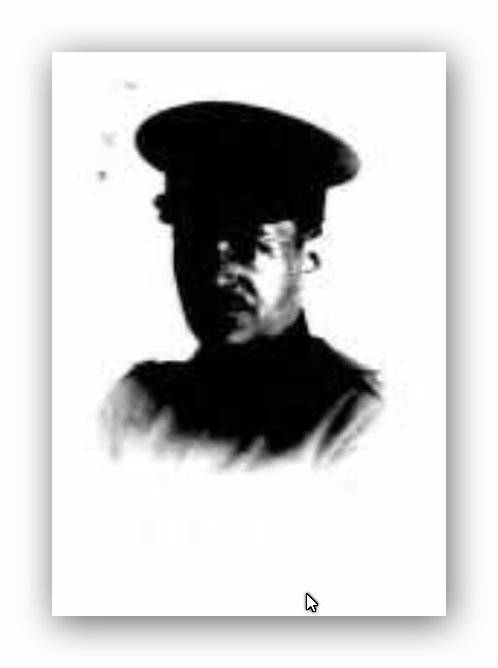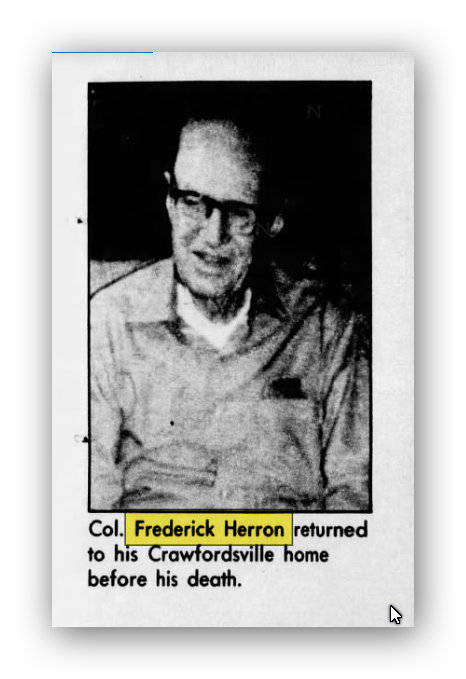Herron - Frederick Lewis
Blakeslee, Ruth. “The Herrons of Crawfordsville.” Indianapolis Star Sun 20 Dec 1981 p 154


Col. Frederick Lewis Herron of Crawfordsville who was Ted to his family and friends died in June at age 94. He had plenty of memories. He should have written a book but he didn’t. His careers ranged from US consul to Panama, military service in two World Wars and treasurer and foreign manager of films for the Motion Picture Producers and Distributors of America. His acquaintances included the Italian dictator Mussolini, the Kennedy family and Mamie Eisenhower. But Crawfordsville was his home and the elaborate gingerbread house in which he and his family lived is still one of the city’s most impressive residences. The home, across from Wabash College was built in 1890 by Col. Herron’s father, Capt. William Parke Herron. With its turret, gables, many chimneys, slate shingles and stained glass windows, it has tremendous eye appeal and is included in Crawfordsville’s walking tour of homes. The inside of the home is as impressive as the outside with a curved and hand-carved satiny oak staircase leading to the upstairs from the front hall, intricately carved wood surrounding three fireplaces, a built-in cherry buffet, among the many attractions. Capt. Herron was in Wilder’s Brigade of the 72nd Indiana Volunteer Infantry and was a member of the executive committee which directed the building of the Soldiers’ and Sailors’ Monument at Indianapolis. He was also on the park commission that placed the Indiana monuments on the Chickamauga Battlefields in Georgia where he had been severely wounded and got tuberculosis. “General Lew Wallace (the author of Ben Hur) lived a few blocks to the east of us,” Col. Frederick Herron recalled in an interview before his death, “and was a frequent visitor in our home. He and father used to sit on the front porch swapping Civil War stories and chuckling. They belonged to a group of men who went fishing on the Kankakee River. Father told us of one occasion when they decided to divide into two groups and have a fishing contest. The general was to go upstream and father to go downstream. When they came in at the end of the day, Wallace had a good many fish but father had very few. Sitting around the campfire that evening the general made much of this and the men all kidded father a lot. But the next morning as they started out, Father saw one of the natives sidle up to Wallace and heard him say, General would you like me to get you some more fish today?”
Capt. Herron was connected with the First National Bank of Crawfordsville for 60 years except for two terms as county treasurer and was its president for many years. He was also president of the original gas company of the city and installed its first gas works. He was also president of the local theater and a central heating company and was a director of other local enterprises and of a large Indianapolis bank.
There were six children born to the captain and his gentle wife, Ada an accomplished musician who played the piano and organ for the Methodist Church for many years. The youngsters included sons: Charles, William Jr, Austin and Frederick (the 5th child) and daughters Jessie and Florence. The four boys all attended Wabash Colle as had their father and were all members of Beta Theta Pi fraternity. The girls attended schools in Indianapolis and studied nursing. Both were instrumental in founding the Red Cross Chapter in Crawfordsville and Florence devoted more than 50 years to Red Cross work. After two years in college, Charles, the oldest, went on to the US Military Academy where he was graduated early to join in the fight in the Philippine jungles. He was a company commander in the Spanish-American War and at one time shared a shack with General Douglas MacArthur as his secretary.
Meanwhile. Frederick had gone through high school in three years and majored in English at Wabash and then at Princeton University. “By then my sister Jessie was married to James Stutesman, a former Congressman from Indiana who was then the US consul to Bolivia. He pulled some strings and got me appointed as the consul to Panama. I was there when the locks were completed and was a guest on the first boat to go through the locks of the canal on Aug 15, 1914. From 1916-1919 Col. Herron was vice consul at Santiago, Cuba where he “wore white suits and swam every day.” When WWI broke out, his brother Charles helped him obtain an assignment in France with the 13th Engineers and then later he switched to the First Division where he advanced to the rank of Major. “When the war ended, the Army retained me in Europe for a period of special service in the allied occupation, in Germany, where I was able to use my former diplomatic experiences as I worked with heads of government.
While Herron resumed civilian life in New York, after five years in the Army, his sister Jessie, by then a widow was working for Will Hays, a lawyer from Sullivan and the man she would later marry.
Hays was named Postmaster General and in 1922 was chosen to become director of the Motion Picture Producers and Distributors of America. The film industry was in trouble and in need of some sort of organization and controlling body and they felt Hays could do the job at $100,000 a year Hays remained the czar of movie morals for 24 years. “Hays chose me to be his treasurer and foreign manager,” the colonel recalled. “My first-hand information with European conditions and problems and my service with the US diplomatic service fitted me ably for the role and by then I pretty well knew my way about in official Europe and Latin America.” Herron worked for Hays for 29 years until he rejoined the army for WWII. And when problems developed with foreign country concerning the use of American films, he and Hays would talk to the various heads of government. He recalled a personal audience with Benito Mussolini, dictator of Italy: “ Mussolini was appreciative of my effort to provide Italy with educational films, so he presented me with a medal – the Italian Cross of Commendatore dell Corona d’Italia. It was a most impressive affair with many important people present. You can believe I literally shook in my boots as I paraded the length of that great room to approach the throne.” Not only did Herron and Hays meet heads of government on diplomatic and business levels, but according to Col. Herron, kings and ambassadors became personal friends of theirs, inviting them to share in their social lives. Herron had several clippings of such affairs. In one he and Hays were guests at a dinner at Claridge’s in London, hosted by the American Ambassador and Mrs. George Harvey and given for Mrs. William Randolph Hearst. “It was all very thrilled to me,” the colonel said. “I could dress as neat and ritzy as any of them and by then I’d developed a lot of polish in my talk and manners. I don’t know how my friends back home and my family could stand me then for I became quite a name dropper, bragging about all my contacts with the people of great importance.” Hays was routinely invited as a house guest in the homes of America’s foreign ambassadors and as his foreign manager Herron was always included. “”I remember visiting in the home of Joseph and Rose Kennedy during the three and a half years Kennedy was the American ambassador to England. Rose was always most gracious and a real lady. Kennedy was an exceptional ambassador and could lay on the charm but was hard as nails..” Herron also received an invitation to the wedding of John Kennedy and Jacqueline Bouvier. He knew her parents as well. At one time the colonel escorted Mamie Eisenhower to his brother Charles’ home for dinner. “Ike was overseas then,” he recalled. “Charles and Louise had a habit of entertaining the wives who had to stay behind and this particular time I was the chauffeur. I was quite fond of Mamie and I thought she was very sweet.”
At the advent of WWII in 1941, the colonel returned to the Army, where he served the next four years in the Adjutant General’s Department in Washington DC. There he was notified of all matters of importance discussed with the British, given all information and material for transmission to the British embassy and had to clear all projects undertaken for the British Ministry of Economic Warfare.
Austin had also returned to the Army from his job as president of the First National Bank at Attica, Ind and advanced to the rank of Major. William remained an engineer for the Rapid Transit Company in Chicago. And Charles, who had retired in 1941 as department commander of the Hawaiian division of the US Army was recalled to service to be a member of the personnel board of the Secretary of War. At the war’d end Charles received the Oak Leaf Cluster to add to a Distinguished Service Medal and was promoted to major general. He and his wife retired to Hawaii and he lived to be 100.
Col. Herron never married though at near 6’ tall and with better than average looks he was much admired by many women.
“As a young man I was a string bean and the girls just weren’t attracted to me,” he said. There was a girl in Crawfordsville I was fond of but she married my best friend. Then I went off to Panama and the war and had this position that kept me on the run..” After his exciting Army and business careers, and after his retirement to his Crawfordsville home, Col. Herron indulged his love for opera, golf and horseback riding. He lived quietly in the home of his beginning with his two sisters who were widowed. Though he outlived his family, they remained with him in his memories and he was proud of them. Since the colonel’s death the Herron House has been sold. But its owners plan to keep it as a Crawfordsville heritage. They share the city’s pride in the patriotic family and their unusual home.
Sorry not sure where the photo in uniform is from but the other one is from the article above


